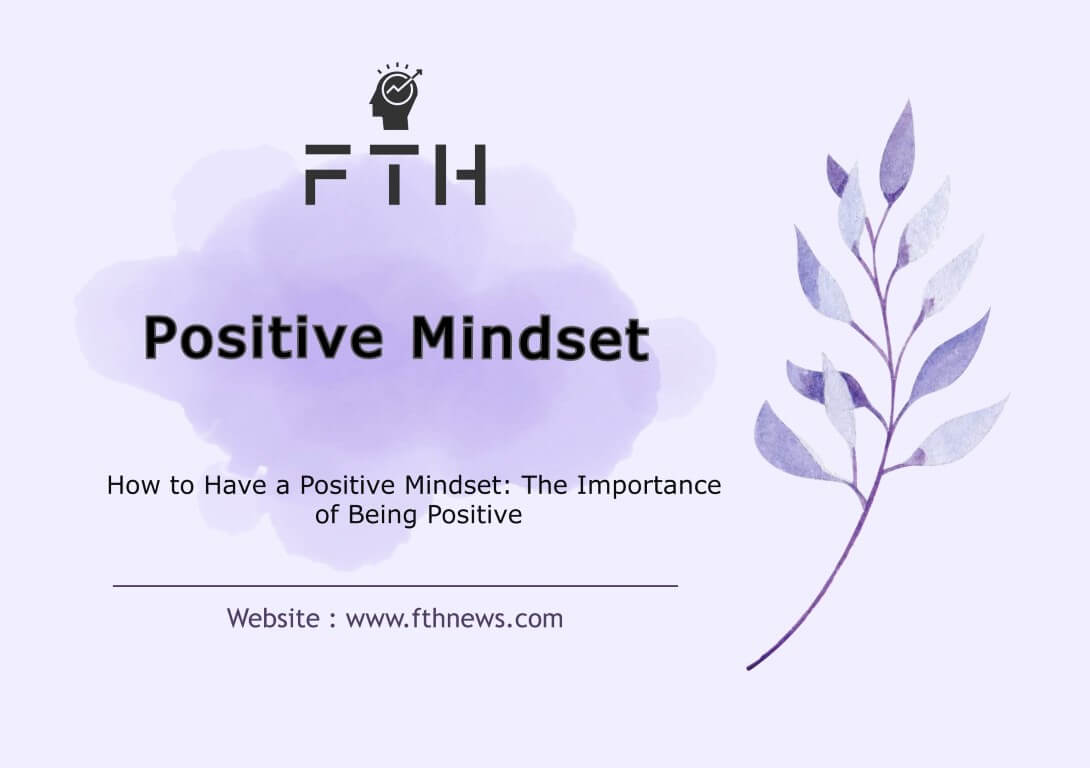
In a world filled with challenges and uncertainties, maintaining a positive mindset has become a crucial aspect of overall well-being. This blog post aims to provide a comprehensive guide on “How to Have a Positive Mindset,” offering practical tips and actionable steps to foster a more optimistic outlook on life.
What Is positivity OR Positive Mindset ?
Positivity or a Positive Mindset refers to a mental and emotional state characterized by an optimistic and constructive approach to life’s challenges and experiences. It involves cultivating a mindset that focuses on the good aspects of situations, people, and oneself, while minimizing dwelling on negativity or obstacles. Having a positive mindset is not about ignoring difficulties or denying the existence of problems; rather, it’s about approaching them with a proactive and hopeful attitude.
Key elements of positivity and a positive mindset include:
- Optimism: A positive mindset involves expecting favorable outcomes and anticipating success, even in the face of challenges.
- Gratitude: Appreciating and acknowledging the positive aspects of life, both big and small, contributes to a positive mindset. This often involves cultivating a sense of gratitude for what one has.
- Resilience: Positive individuals are better equipped to bounce back from setbacks. They see failures as opportunities for growth and learning rather than insurmountable obstacles.
- Solution-Oriented Thinking: Instead of dwelling on problems, those with a positive mindset actively seek solutions. They focus on what can be done rather than what cannot.
- Self-Belief: Maintaining confidence in one’s abilities and potential is a crucial aspect of a positive mindset. This involves recognizing and building on one’s strengths.
- Mindfulness: Being present in the moment and appreciating the current experience without excessive worry about the past or future contributes to a positive mindset.
- Positive Relationships: Surrounding oneself with supportive and uplifting individuals can enhance and sustain a positive mindset. Social connections play a significant role in overall well-being.
- Adaptability: Embracing change and viewing challenges as opportunities for growth are hallmarks of a positive mindset. Flexibility in thinking and behavior is a key component.
Developing a positive mindset is a continuous process that involves self-awareness, intentional thought patterns, and the cultivation of habits that foster optimism and resilience. By incorporating positivity into daily life, individuals can enhance their mental well-being, improve relationships, and navigate challenges more effectively.
How to Have a Positive Mindset
In a world filled with challenges and negativity, cultivating a positive mindset is crucial for personal well-being and success. Embracing positivity not only benefits you but also radiates positive energy to those around you. In this blog post, we’ll explore 15 actionable steps to help you develop and maintain a positive view of life.
Look for Happiness Within Yourself:
Embarking on a journey to find happiness within oneself is akin to discovering a hidden treasure. The realization that happiness is an inside job marks the crucial first step toward cultivating a positive mindset. Rather than tethering our joy to external factors that are often beyond our control, we should delve into the reservoir of our own emotions and thoughts.
For instance, consider the case of Sarah, who found contentment by practicing mindfulness and gratitude. Despite facing challenges in her career, Sarah focused on appreciating the simple joys in life, such as spending time with loved ones and pursuing hobbies. By understanding that our internal state plays a pivotal role in shaping our overall well-being, we lay the foundation for sustained happiness.
Practice Positive Thinking:
In the intricate tapestry of life, the thread of positive thinking weaves a pattern of success and fulfillment. This practice is not merely an optimistic outlook but a conscious choice to shape our reality. Positive thinking acts as a catalyst, opening doors to success and happiness across various dimensions of our lives. Take, for example, the story of John, who approached setbacks with a positive mindset.
Instead of dwelling on failures, John viewed them as valuable learning experiences that propelled him toward personal growth and achievement. By intentionally selecting thoughts that uplift and inspire, we create a roadmap to navigate challenges and embrace opportunities with a resilient spirit.
Exercise Regularly:
Engaging in regular physical activity transcends the boundaries of mere fitness – it’s a transformative practice for both body and mind. Beyond the physical benefits, exercise releases endorphins, often referred to as the “feel-good” hormones. These biochemical wonders act as natural mood enhancers, alleviating stress and contributing to an overall positive mental state.
For a tangible example, consider the case of Mark, who incorporated a daily morning jog into his routine. The endorphin boost not only invigorated him physically but also set a positive tone for the rest of his day, enhancing his productivity and outlook on life. Regular exercise, therefore, stands as a potent tool for not only maintaining but actively fostering a positive mindset.
Stay Away From People With Negative Thoughts:
Our social circles exert a profound influence on our thoughts, attitudes, and ultimately, our mindset. Surrounding yourself with positive influences becomes paramount in cultivating and preserving a positive outlook on life. Negative energy, akin to a drain on our emotional resources, can hinder personal growth and positivity.
Consider the scenario of Susan, who consciously distanced herself from individuals consistently harboring negative thoughts. The shift in her social environment allowed her to thrive, fostering a more optimistic and empowering mindset. By choosing to be around people who uplift and inspire, we create an environment conducive to sustained positivity and personal development.
Spend Time in Nature:
In the hustle and bustle of modern life, reconnecting with nature is a powerful antidote for mental fatigue and stress. Nature has a profound impact on mental well-being, offering a sanctuary for reflection and rejuvenation. Take a moment to envision Julia, who found solace in the simplicity of nature. Whether lying on the grass, walking in the snow, or basking in the sunlight filtering through the trees, these experiences became therapeutic. Scientifically, exposure to nature has been linked to reduced levels of stress and increased feelings of happiness.
Spending time outdoors, therefore, is not just a leisure activity but a strategic investment in mental wellness. Nature’s wonders serve as a reminder that in the midst of life’s complexities, simplicity and serenity are essential for maintaining a positive mindset.
Find Reasons to Believe in Yourself:
Life is a journey adorned with both triumphs and setbacks. Amidst the ebb and flow, it becomes imperative to focus on the victories, however small, and the strengths that define our character. Instead of dwelling on failures, viewing them as stepping stones rather than roadblocks allows us to uncover reasons to believe in ourselves.
Consider the journey of Emily, who overcame self-doubt by celebrating her accomplishments. Despite facing criticism from peers, Emily remained steadfast in her belief in her abilities, eventually achieving her goals and inspiring others in the process. The art of self-affirmation and recognizing personal achievements fosters a profound sense of confidence. This confidence, in turn, becomes the bedrock of a positive outlook, propelling us toward new horizons with resilience and optimism.
Avoid Impulsive Spending:
In our consumer-driven society, the allure of impulsive spending can cast a shadow on our financial well-being and, consequently, our mental health. Financial stress often acts as a catalyst for negativity, impacting various facets of our lives.
To illustrate, consider the case of Alex, who recognized the detrimental effects of impulsive spending on his financial stability. By resisting the urge for momentary gratification and practicing mindful budgeting, Alex not only avoided long-term financial strain but also experienced a notable improvement in his overall well-being. The key here lies in making conscious, informed decisions about our expenditures, ensuring that they align with our long-term financial goals and contribute positively to our mental outlook.
Learn to Accept Failure:
In the pursuit of success, setbacks and failures are inevitable companions. Rather than viewing failure as a dead-end, successful individuals embrace it as an integral part of the journey.
Take the example of Maya, who encountered a significant setback in her entrepreneurial venture. Instead of succumbing to despair, she analyzed the situation, identified lessons learned, and used the experience as a stepping stone toward future success. Learning from failures is not a sign of weakness but a testament to resilience and a proactive approach to personal growth. By adopting this mindset, we not only mitigate the impact of failure on our mental well-being but also harness its transformative potential.
Learn to Take Responsibility:
Empowerment lies in taking full responsibility for our lives and decisions, recognizing that we are the architects of our own destiny. Positive people understand the pivotal importance of accountability in shaping a fulfilling life.
Consider the journey of Michael, who, despite facing external challenges, took responsibility for his reactions and decisions. By acknowledging his role in shaping his external circumstances, Michael regained a sense of control over his life. This empowered perspective allowed him to navigate challenges with resilience and actively work towards positive outcomes. Taking responsibility is not about blaming oneself but rather about embracing the power to influence our own narrative. By doing so, we pave the way for a positive and purposeful existence.
Learn to Control Your Thoughts:
The intricate dance between thoughts and reality underscores the profound impact our mental landscape can have on our daily experiences. Learning to control our thoughts is akin to wielding the brush that paints the canvas of our lives. Consciously directing our thoughts toward positivity, especially in challenging situations, can be transformative.
Consider the case of Michelle, who, when faced with professional setbacks, actively reframed her thoughts from dwelling on obstacles to focusing on potential solutions. By taking control of her thought patterns, Michelle not only navigated challenges more effectively but also cultivated a resilient and optimistic mindset. This practice isn’t about ignoring difficulties but rather about actively shaping our perspective to see opportunities within challenges.
Give Yourself Time:
In the fast-paced rhythm of modern life, it’s easy to overlook the importance of dedicating time for self-care and reflection. Like a garden that requires regular tending, our minds benefit from moments of “thought detox.”
Sarah, a busy professional, scheduled brief intervals throughout her day for self-reflection. During these pauses, she engaged in activities that brought her joy, from listening to calming music to practicing mindfulness. This deliberate commitment to self-care acted as a reset button, preventing the accumulation of negative thoughts and allowing her to approach challenges with renewed positivity. Giving yourself time isn’t an indulgence but a vital investment in mental well-being and the cultivation of a positive mindset.
Know That There Is Always a Solution:
Life’s journey is peppered with challenges, and navigating them requires an unwavering belief that there is always a solution. This mindset is not merely a platitude but a powerful anchor that keeps us resilient in the face of adversity.
Reflect on the story of James, who, despite encountering significant personal and professional setbacks, held firm to the conviction that every problem carries within it the seed of a solution. By acknowledging that challenges are temporary and embracing the belief in brighter days ahead, James not only weathered difficult times but emerged stronger and more positive. Cultivating a positive mindset involves recognizing that solutions often reveal themselves when approached with a proactive and optimistic perspective.
Remember That Your Happiness Matters:
Amidst life’s demands and responsibilities, it’s crucial to prioritize your own happiness. This isn’t a selfish pursuit but a recognition that your well-being forms the foundation for positive interactions and contributions to others.
Consider the story of Emily, who, in her quest for external validation, found herself continuously drained. Through introspection, she realized the importance of self-care and cultivating inner contentment. By prioritizing her happiness, Emily not only experienced personal fulfillment but also became a source of genuine joy for those around her. Your happiness is not a luxury but a prerequisite for spreading positivity and enriching the lives of others.
Don’t Wait for Others’ Approval:
Taking control of your life requires making decisions that align with your values and aspirations. Waiting for external approval can be a hindrance to personal growth and the development of a positive mindset.
Picture the journey of David, who hesitated to pursue his passion for art because he feared disapproval from his peers. When he finally embraced his artistic pursuits, the newfound joy transformed not only his life but also inspired those around him. By breaking free from the shackles of external validation, David exemplified the empowering impact of making decisions aligned with personal values. Remember, the path to a positive mindset often involves confidently charting your course, irrespective of others’ opinions.
Let the Past Stay in the Past:
Our past is a mosaic of experiences, some uplifting and others challenging. However, allowing past mistakes to cast a shadow on the present can hinder personal growth and positivity.
Imagine the story of Rachel, who, after a career setback, initially dwelled on what went wrong. Through resilience and a conscious effort to let go, she redirected her focus to the present. By cherishing the moments she was living and learning from past experiences, Rachel not only found renewed purpose but also embraced the beauty of life unfolding in the now. Learning to let the past stay in the past is a transformative practice that opens the door to a more positive and fulfilling present. Life is too short to be tethered to yesterday’s missteps or constantly preoccupied with an uncertain future—embrace the perfect moments you are living now.
Embrace Continuous Learning:
Life is a journey of growth and discovery, and a positive mindset thrives on a curious and open approach to learning. Actively seek out opportunities for self-improvement, whether through formal education, workshops, books, or online courses. Cultivating a love for learning not only expands your knowledge but also fosters adaptability, resilience, and a proactive mindset.
Consider the example of Alex, who, despite a successful career, enrolled in a course to learn a new skill. This commitment not only invigorated his passion for personal development but also brought a renewed sense of purpose and positivity into his life.
Nurture Gratitude:
In the hustle of daily life, it’s easy to overlook the blessings that surround us. Cultivate a habit of gratitude by regularly reflecting on the positive aspects of your life. This could involve keeping a gratitude journal or simply taking a moment each day to acknowledge and appreciate the people, experiences, and opportunities that bring joy.
Studies have shown that practicing gratitude is linked to increased happiness and well-being. Sarah, for instance, incorporated a nightly gratitude ritual, transforming her perspective and contributing to a more positive outlook.
By integrating these additional steps into the existing framework, you’ll create a holistic approach to fostering a positive mindset that encompasses continuous growth and gratitude. Remember, the journey toward positivity is ongoing, and each step contributes to a more fulfilling and optimistic way of life.
How to keep a Positive Mindset?
Congratulations on making the shift from a negative to a positive mindset! Here are some strategies to help you maintain and solidify your positive outlook:
Consistent Self-Reflection:
Regularly check in with yourself. Reflect on your thoughts, emotions, and overall mindset. Identify any negative patterns and actively work on redirecting them towards positivity.
Create a Positive Environment:
Surround yourself with positive influences. Choose to spend time with people who uplift and inspire you. Cultivate a home and work environment that reflects positivity.
Set and Pursue Meaningful Goals:
Establish clear and achievable goals that align with your values. Working towards these goals can provide a sense of purpose and keep you motivated.
Celebrate Small Wins:
Acknowledge and celebrate your successes, no matter how small. Recognizing achievements, no matter how minor, reinforces a positive mindset.
Mindful Awareness:
Practice mindfulness to stay present and appreciate the current moment. Mindful awareness can help you let go of unnecessary worries about the past or future.
Positive Affirmations:
Continue using positive affirmations to reinforce your optimistic mindset. Regularly remind yourself of your strengths and capabilities.
Gratitude Practice:
Maintain a gratitude journal and continue to express thanks for the positive aspects of your life. Gratitude can shift your focus towards the positive aspects of each day.
Learn from Challenges:
View challenges as opportunities for growth. Embrace setbacks as valuable lessons, and approach them with a problem-solving mindset.
Limit Negative Influences:
Be mindful of negative influences, whether they come from people, media, or your own thoughts. Limit exposure to negativity and consciously choose positive alternatives.
Stay Active and Healthy:
Continue to prioritize your physical well-being. Regular exercise, a balanced diet, and adequate sleep contribute to both physical and mental health.
Develop a Support System:
Cultivate a network of supportive friends and family. Share your positive journey with them, and seek their encouragement during challenging times.
Practice Acts of Kindness:
Engage in acts of kindness towards others. Helping and supporting others can reinforce your positive outlook and create a ripple effect of positivity.
Visualize Success:
Picture yourself achieving your goals and living a positive life. Visualization can help reinforce a positive mindset by creating a mental image of your desired future.
Learn to Manage Stress:
Develop stress management techniques to cope with challenges. Techniques such as deep breathing, meditation, or yoga can help you maintain calmness and a positive perspective.
Stay Open to Learning:
Embrace a growth mindset and stay open to learning. Approach new experiences with curiosity and see challenges as opportunities for personal development.
Remember, maintaining a positive mindset is an ongoing journey. Consistency in practicing these strategies will help solidify your positive outlook and contribute to a more fulfilling and optimistic life.
Understanding the Power of Positive Mindset
Embracing a positive mindset goes beyond mere optimism; it involves tapping into the profound psychological and physiological benefits that come with cultivating positivity. Numerous scientific studies underscore the transformative impact of positive thinking on various aspects of our well-being.
Psychological Benefits:
Research consistently demonstrates that maintaining a positive mindset contributes significantly to mental health. Positive thoughts and emotions are linked to reduced symptoms of depression, anxiety, and stress. Studies in positive psychology reveal that individuals with an optimistic outlook tend to experience higher levels of life satisfaction and subjective well-being.
Physiological Benefits:
The mind-body connection is a powerful force, and positive thinking can influence our physiological responses. Studies have shown that a positive mindset can lead to lower levels of cortisol, the stress hormone, resulting in reduced stress and better overall health. Moreover, positive emotions have been associated with improved cardiovascular health and a strengthened immune system.
Impact on Happiness:
Delving into the science of positivity unveils its direct correlation with happiness. Positive thoughts trigger the release of neurotransmitters like serotonin and dopamine, often referred to as the “feel-good” chemicals. Understanding these neurological processes reinforces the idea that positivity isn’t just a subjective feeling but a tangible state of well-being with measurable benefits.
Recognizing the Need for a Positive Mindset
Life is a tapestry of challenges, and navigating its complexities requires a resilient and positive perspective. In this subsection, we delve into common hurdles individuals face in their daily lives, emphasizing the pivotal role of a positive mindset as a coping mechanism.
Addressing Daily Challenges:
From workplace stress to personal relationships, individuals encounter a myriad of challenges that can take a toll on their mental and emotional well-being. Acknowledging these challenges is the first step toward effective coping. However, it’s the lens through which we view and respond to these challenges that truly shapes our experience.
The Importance of Perspective:
The need for a positive mindset becomes apparent when we consider how our perspective influences our reactions to challenges. By viewing difficulties as opportunities for growth and learning, individuals can navigate setbacks with resilience. This shift in perspective not only eases the emotional burden but also opens doors to creative problem-solving and personal development.
Coping Mechanism for Well-Being:
Recognizing the need for a positive mindset isn’t just about wishful thinking; it’s a strategic and effective coping mechanism. Studies indicate that individuals who adopt a positive approach to challenges experience lower levels of chronic stress and are better equipped to manage adversity. This section emphasizes that positivity isn’t an abstract concept but a practical and empowering tool for enhancing overall well-being.
By exploring the science behind positivity and acknowledging the need for a positive mindset in the face of life’s challenges, individuals can lay the groundwork for a more resilient, content, and fulfilling life.
The importance of being positive in life and work
Maintaining a positive outlook on life and work is crucial for various reasons, as it influences not only individual well-being but also the overall quality of relationships and productivity in the workplace. Here are some key aspects highlighting the importance of being positive in life and work:
1. Mental and Emotional Well-being:
- Reduced Stress: Positivity has been linked to lower stress levels. A positive mindset helps individuals cope with challenges more effectively, reducing the impact of stress on mental health.
- Enhanced Resilience: Positivity fosters resilience, enabling individuals to bounce back from setbacks and adapt to changing circumstances with greater ease.
2. Improved Physical Health:
- Boosted Immune System: Research suggests that positive emotions contribute to a stronger immune system, leading to better overall health and a lower likelihood of illness.
- Increased Longevity: Studies indicate that individuals with a positive outlook on life tend to live longer, possibly due to the stress-reducing and health-promoting effects of positivity.
3. Enhanced Productivity and Performance:
- Increased Motivation: Positive individuals are often more motivated and engaged in their work. A positive mindset can fuel a sense of purpose and drive, leading to higher levels of productivity.
- Creativity and Problem-Solving: Positive thinking encourages open-mindedness and creativity, fostering innovative solutions to challenges in the workplace.
4. Positive Relationships:
- Improved Communication: Positivity contributes to better communication and collaboration with colleagues. It creates a more harmonious work environment where individuals are supportive and understanding.
- Building Trust: Positive individuals are generally perceived as more trustworthy, leading to stronger relationships with peers, supervisors, and clients.
5. Leadership Effectiveness:
- Inspirational Leadership: Positive leaders inspire and motivate their teams. They create a work culture where employees feel valued and encouraged to contribute their best efforts.
- Adaptability: Positive leaders are better equipped to navigate change and uncertainty, fostering a sense of confidence and trust among team members.
6. Career Advancement:
- Optimistic Outlook: Employers often value employees who bring a positive attitude to the workplace. Positive individuals are more likely to be seen as team players and contributors to a healthy organizational culture.
- Networking: Positive individuals tend to build better professional networks. Their optimistic approach makes them more approachable and memorable in various professional settings.
7. Work-Life Balance:
- Enhanced Well-being: A positive mindset contributes to a better work-life balance. It helps individuals prioritize their mental and emotional health, reducing the negative impact of work-related stress on personal life.
In summary, cultivating a positive outlook in both life and work contributes to improved well-being, better relationships, and increased success. It’s not just a personal trait but a valuable asset that positively impacts the entire professional and personal landscape.
Conclusion:
Achieving and maintaining a positive mindset is an ongoing journey that requires dedication and effort. By implementing these 17 steps, you’ll be on the path to unlocking the power of positivity in your life, radiating joy to those around you and creating a ripple effect of optimism in the world. Remember, even small efforts can lead to significant positive changes over time. Embrace the journey towards a brighter, more positive future!
FAQ
Cultivate gratitude, focus on solutions, surround yourself with positivity, learn from challenges, and practice self-compassion.
Optimism, gratitude, resilience, kindness, and openness to learning.
Use positive affirmations, practice mindfulness, engage in positive self-talk, celebrate small wins, and consciously choose a positive perspective.














